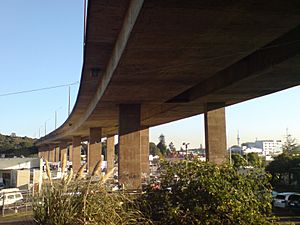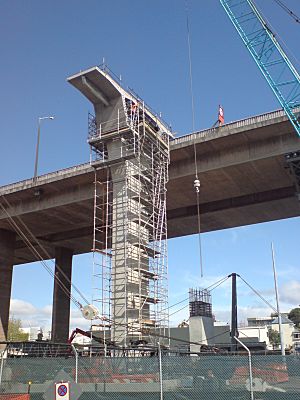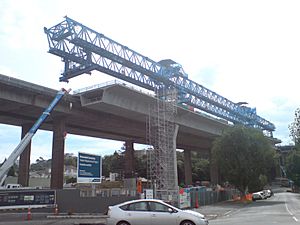Newmarket Viaduct facts for kids
The Newmarket Viaduct is a very important viaduct (a long bridge) in Auckland, New Zealand's biggest city. It's often called one of the most special engineering projects in the country. This huge bridge carries the Southern Motorway over the Newmarket area, which is southeast of the city centre. The viaduct is about 700 metres long and can be as high as 20 metres in some places. It has seven lanes for cars and trucks.

Contents
The First Bridge
The first Newmarket Viaduct opened on 3 September 1966. It cost about NZ$2.26 million to build. This bridge was special because it was New Zealand's first pair of 'balanced cantilever bridges'. This means parts of the bridge stick out from supports, balancing each other.
Even today, it's a complicated structure because of its long sections, curved shape, and changing road slope. At the time, it was a very new and exciting design for New Zealand.
Why the Old Bridge Needed Replacing
While the first viaduct was a good design, it wasn't built to handle big earthquakes as well as modern bridges. It was only designed to survive an earthquake that happens once every 500 years. This meant it could get badly damaged in an earthquake that happens more often, like once every 200 years. This made the viaduct the weakest link for motorway travel in Auckland, meaning it could stop all traffic to the south if it collapsed.
Also, when it was designed, engineers didn't fully understand how temperature changes affect bridges. This caused parts of the bridge to wear out faster.
Planning a New Bridge
Because of the earthquake risk and the huge amount of traffic (over 200,000 vehicles every day!), a new viaduct was planned. This new bridge needed to be strong enough to survive a very rare earthquake, one that happens only once every 2,500 years.
There were other reasons for a new bridge too:
- Safety barriers: The old barriers were too low. In 2004, a truck went over the side and fell 15 metres! The barriers also didn't stop small things from falling onto properties below.
- Heavy trucks: Very heavy trucks weren't allowed on the old viaduct. This meant they had to drive through busy city streets instead.
Engineers thought about repairing the old bridge. However, it was hard to make its parts stronger, and even a repaired bridge would only last another 40 to 50 years. A brand new bridge would cost only about 15% more but would last for over 100 years. So, building a completely new viaduct was the best choice.
Building the New Bridge
The new bridge project was estimated to cost NZ$150 million. It got approved faster than expected, and people hoped it would be ready for the 2011 Rugby World Cup. The project was planned to take three years, starting around 2009 or 2010. It was approved quickly because there were no old historical sites in the way and not many homes were affected by the new bridge.
How the New Bridge Was Designed
The new viaduct was designed so that traffic on this very busy motorway would be affected as little as possible. Here's how they planned it:
- First, they built a new section with four southbound lanes (going south) next to the old bridge.
- Then, they took down the old three southbound lanes.
- Next, they built the three new northbound lanes (going north) in the empty space.
- Finally, they took down the old three northbound lanes.
Engineers decided to build the new bridge using 468 pre-made concrete sections. These sections were built somewhere else in East Tāmaki and then lifted into place using a special crane.
The companies Tonkin + Taylor and URS New Zealand helped design the new bridge. They aimed to recycle all the old materials from the project. They also used what they learned from building the Waiwera Viaduct for this new project.
By June 2008, the estimated cost had gone up to NZ$187 million. By October 2008, the funding was confirmed, but the price increased again to NZ$195 million. This was due to higher costs for fuel, building materials, and workers. Even though they were still ahead of schedule, only part of the new viaduct was finished in time for the 2011 Rugby World Cup.
The new viaduct is much better for the people living nearby. It has special noise-absorbing road surfaces, strong concrete barriers, and some noise walls. The project also included improvements like a walkway from Gillies Avenue down to Newmarket, which has a volcanic theme.
Building the Bridge
Construction officially started in April 2007. Workers began building the foundations for the new southbound part of the viaduct, which would have piers (support columns) up to 18 metres high.
Over Easter 2009, a strong support structure was put in place under the section that crosses the railway line. A huge, 140-metre-long, 800-ton crane called a 'launching gantry' was set up above Newmarket. This crane moved new sections into place and helped stabilise parts of the old bridge that were being taken down. Taking down the old bridge was considered the hardest part of the project.
The new southbound section was planned to be finished by the end of 2010. The northbound section was expected to take until at least March 2012. During construction, special screens were used to stop drivers from being distracted. The traffic lanes were made narrower, and the speed limit on the viaduct was lowered to 70 km/h. Many temporary supports were also needed to safely handle the weight and stress while parts of the bridge were being taken down and rebuilt.
The construction process made sure that the motorway could mostly stay open. This was very important for keeping traffic moving in Auckland. Other work around the viaduct included building the volcanic-themed walkway and upgrading a footbridge over State Highway 1 at Mt Hobson Road.
The new viaduct is made of 468 separate bridge deck sections. These were made in a special factory in East Tāmaki before being brought to the site. Over 150 people worked directly on this big project.
Awards
The challenging work of taking down the old viaduct sections while building the new ones right next to them won an award! It received the Civils Demolition Award at the 2012 World Demolition Awards.
Images for kids





